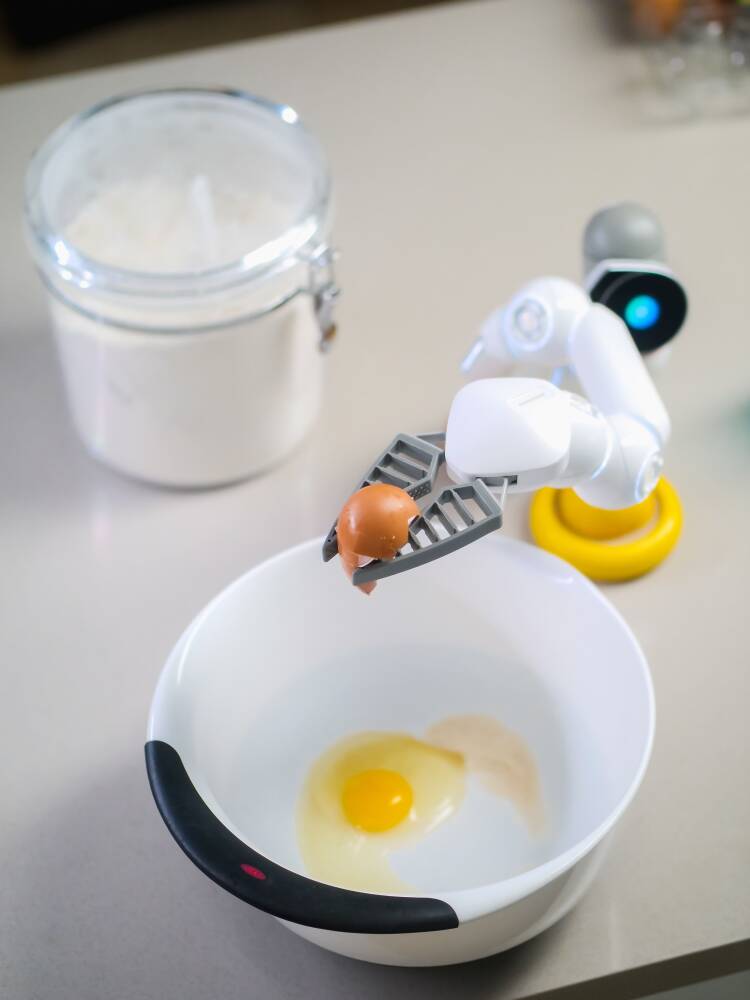TRENDWATCH
Creating Flavors
One chef who has been working on AI for several years is Nicolas Maire. He is particularly fascinated by how AI can be used to help with the creative process of product development or recipe creation. Maire is a classic French top chef who received over 18 Michelin stars during the course of his career. Maire has since left the restaurant kitchen, and now works as a culinary consultant at Firmenich. The Swiss company was founded in 1895, and began in the perfume industry. Today, the company is engaged in the development of meat substitutes. Maire helps develop flavors for new products with a team of master flavorists; experts in creating new flavors. The profession is so rare that there are only 30 master flavorists worldwide; it can be compared to the "Noses" in the perfume industry.
Currently, a team of master flavorists at Firmenich are being assisted by an Artificial Intelligence system called Sam. Sam is trained using a database of ingredients that master flavorists at Firmenich have collected over 60 years. With all this data, the robot can generate new flavors and combinations within minutes, suitable as a starting point from which the master flavorists can start their creative process of creating flavors for a new product.
4 min


The way AI will change the way we eat










“When we think about the current world of shopping for groceries, or using meal kits, you can filter your search or perhaps modify ingredients so you can sort of get what you want,” says co-founder and CEO Martin Salo, in an interview with TechCrunch. “Figuring out what all the ingredients contain, and what happens if you change one ingredient, does it throw everything off balance? This can be a lot of work. While doing your monthly shopping, you might go through hundreds of items; do you have time to read all of those labels? So, what if you don’t talk about each individual ingredient but instead make broader choices? That’s where Yummy comes in with its AI, giving users the option to compose dishes using different parameters. For example, you could say ‘I want five fish dishes,’ then ‘Okay, now make it cheaper,’ or ‘I want this to be a balanced diet’."
In which ways AI will become a part of our everyday lives will remain to be seen. For now, they are handy systems that can help people in creative processes - including the kitchen. Fortunately, you can always choose whether to add that anchovy to your dish… or not.
P.S. This article was not written using artificial intelligence…
AI as a tool to personalize diets
An example of a company that uses AI as a tool to create recipes is the Estonian start-up Yummy, a meal-kit business that helps customers skip the hassle of meal-planning and grocery shopping. What started as an ‘ordinary’ meal-kit company became an AI-driven service that can create and adapt recipes based on people's taste and dietary restrictions, complete with AI-generated images of what their dishes might look like.
Within foodservice, forms of Artificial Intelligence that quickly come to mind are tools that can improve efficiency back-of-house. Think of the optimization of logistics processes, or the way many dark kitchens use algorithms to predict their customers’ needs and desires. But, as AI systems are becoming increasingly more intelligent, the possibilities are growing. One example is in recipe creation.
Traditionally, creating recipes takes time and a lot of energy, research, creativity and test cooking. With AI tools becoming more widely available, they can help us analyze thousands of techniques in search of the best way to make, for example, a loaf of bread. Or, imagine the way that AI can help answer the question of what different Japanese fermentation techniques can be applied to celeriac, within seconds.
Historically, the concept of ‘the robot’ has been the same - to help people with routine work. But Artificial Intelligence is changing rapidly, and the ways in which we imagined robots would be part of our future, might look a little different now. Instead of Roomba the robot vacuum cleaner, or Aibo the robot companion dog assisting us during our work and daily tasks, we can now turn to chatbots, and other online programs that are data driven to help us.
Lisa Appels Loraine Elemans
Can Artificial Intelligence help us decide what’s for dinner?




4 min


Creating Flavors
One chef who has been working on AI for several years is Nicolas Maire. He is particularly fascinated by how AI can be used to help with the creative process of product development or recipe creation. Maire is a classic French top chef who received over 18 Michelin stars during the course of his career. Maire has since left the restaurant kitchen, and now works as a culinary consultant at Firmenich. The Swiss company was founded in 1895, and began in the perfume industry. Today, the company is engaged in the development of meat substitutes. Maire helps develop flavors for new products with a team of master flavorists; experts in creating new flavors. The profession is so rare that there are only 30 master flavorists worldwide; it can be compared to the "Noses" in the perfume industry.
Currently, a team of master flavorists at Firmenich are being assisted by an Artificial Intelligence system called Sam. Sam is trained using a database of ingredients that master flavorists at Firmenich have collected over 60 years. With all this data, the robot can generate new flavors and combinations within minutes, suitable as a starting point from which the master flavorists can start their creative process of creating flavors for a new product.




“When we think about the current world of shopping for groceries, or using meal kits, you can filter your search or perhaps modify ingredients so you can sort of get what you want,” says co-founder and CEO Martin Salo, in an interview with TechCrunch. “Figuring out what all the ingredients contain, and what happens if you change one ingredient, does it throw everything off balance? This can be a lot of work. While doing your monthly shopping, you might go through hundreds of items; do you have time to read all of those labels? So, what if you don’t talk about each individual ingredient but instead make broader choices? That’s where Yummy comes in with its AI, giving users the option to compose dishes using different parameters. For example, you could say ‘I want five fish dishes,’ then ‘Okay, now make it cheaper,’ or ‘I want this to be a balanced diet’."
In which ways AI will become a part of our everyday lives will remain to be seen. For now, they are handy systems that can help people in creative processes - including the kitchen. Fortunately, you can always choose whether to add that anchovy to your dish… or not.
P.S. This article was not written using artificial intelligence…
AI as a tool to personalize diets
An example of a company that uses AI as a tool to create recipes is the Estonian start-up Yummy, a meal-kit business that helps customers skip the hassle of meal-planning and grocery shopping. What started as an ‘ordinary’ meal-kit company became an AI-driven service that can create and adapt recipes based on people's taste and dietary restrictions, complete with AI-generated images of what their dishes might look like.






Within foodservice, forms of Artificial Intelligence that quickly come to mind are tools that can improve efficiency back-of-house. Think of the optimization of logistics processes, or the way many dark kitchens use algorithms to predict their customers’ needs and desires. But, as AI systems are becoming increasingly more intelligent, the possibilities are growing. One example is in recipe creation.
Traditionally, creating recipes takes time and a lot of energy, research, creativity and test cooking. With AI tools becoming more widely available, they can help us analyze thousands of techniques in search of the best way to make, for example, a loaf of bread. Or, imagine the way that AI can help answer the question of what different Japanese fermentation techniques can be applied to celeriac, within seconds.


Historically, the concept of ‘the robot’ has been the same - to help people with routine work. But Artificial Intelligence is changing rapidly, and the ways in which we imagined robots would be part of our future, might look a little different now. Instead of Roomba the robot vacuum cleaner, or Aibo the robot companion dog assisting us during our work and daily tasks, we can now turn to chatbots, and other online programs that are data driven to help us.
Lisa Appels Loraine Elemans
The way AI will change the way we eat
Can Artificial Intelligence help us decide what’s for dinner?











